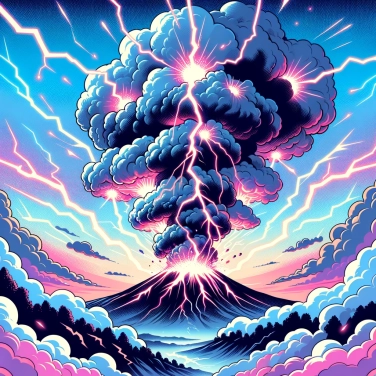The lightning observed during volcanic eruptions is generally due to the friction between ash particles, dust, and gas which rub against each other and become electrically charged, causing electrical discharges.

The occurrence of lightning during a volcanic eruption is a fascinating phenomenon but still poorly understood by science. Volcanoes can produce lightning of different colors, ranging from blue to red to purple. These lightning bolts can form in various places, such as the volcano's summit, ash plumes, or pyroclastic flows. Several factors can contribute to the formation of lightning during a volcanic eruption, including friction between ash particles, separation of electric charges, and the presence of ionized gases. Volcanic lightning can be extremely powerful and pose an additional danger to people living near erupting volcanoes. Researchers continue to study this phenomenon to better understand its mechanisms and eventually improve the prediction of volcanic eruptions.
When a volcano erupts, electrical phenomena can occur, creating lightning above the crater. The formation of these volcanic lightning is a complex process related to the presence of ashes, particles of molten rock, and gas in the eruptive plume.
Volcanic ashes can rub against each other at high speed during the eruption, creating an electric charge. This charge can accumulate in the ash clouds and cause electrical discharges, manifesting as lightning.
The particles of molten rock present in the eruptive plume can also play a role in the formation of volcanic lightning. When these particles are ejected into the atmosphere, they can become electrically charged by interacting with the surrounding gases and ashes, contributing to the generation of lightning.
Finally, the presence of gases such as sulfur dioxide in the eruptive plume can also influence the formation of volcanic lightning. When sulfur dioxide is ejected into the atmosphere, it can react with other components present in the ash clouds, creating conditions conducive to the formation of lightning.
In summary, the formation of volcanic lightning results from the complex interaction between ashes, particles of molten rock, and gases present in the eruptive plume. These electrical phenomena associated with volcanic eruptions are a fascinating aspect of the dynamics of active volcanoes.
Volcanic lightning occurs due to the powerful physical processes that take place during a volcanic eruption. One of the key mechanisms at play is the friction between ash and rock particles ejected during the eruption. This intense friction generates an electric charge that accumulates in the ash and gas clouds. When this electric charge reaches a critical level, it discharges in the form of lightning.
Another important mechanism is the collision between ash, ice, and rock particles within the volcanic plume. These collisions result in the separation of electric charges, creating positively and negatively charged areas. When these charges accumulate enough, they dissipate in the form of lightning.
Additionally, the presence of water vapor and sulfur gases in the volcanic plume can also contribute to the formation of lightning. When these gases mix and react in the volcanic environment, they can generate conditions favorable for lightning formation.
Finally, volcanic eruptions often produce electrically charged ash clouds that can interact with the surrounding atmosphere, creating conditions conducive to lightning formation. These different physical mechanisms at play explain why erupting volcanoes sometimes produce impressive lightning.
The flashes observed during volcanic eruptions are called 'volcanic lightning' or 'volcanic storms.' This spectacular phenomenon results from intense friction between ash particles ejected into the air, creating an accumulation of electric charges.
The eruption of the Calbuco volcano in Chile in 2015 produced particularly impressive volcanic thunderstorms, which were photographed and widely shared due to their stunning beauty.
Scientists use various tools to study these lightning flashes, including specialized high-speed cameras, atmospheric electricity sensors, and weather radars. These instruments allow them to analyze the electrical mechanisms that are generally inaccessible directly within volcanic plumes.
In general, volcanic lightning has little impact on local weather. However, a major eruption accompanied by lightning can produce large amounts of ash that can temporarily cool the local or regional atmosphere and affect cloud formation.
The accurate forecasting of volcanic lightning remains challenging. However, scientists can indirectly anticipate its likelihood by studying the characteristics of the eruption, such as the intensity of volcanic particle emissions and the rapid rise of the ash plume.
No, volcanic lightning does not occur systematically during every eruption. It mainly depends on specific environmental factors, such as the chemical composition of the ash, its density, the strength of the eruption, and the surrounding weather conditions.
Yes, volcanic lightning can pose additional risks as it can trigger fires, damage electrical infrastructure, and further complicate rescue or evacuation operations.

No one has answered this quiz yet, be the first!' :-)
Question 1/5